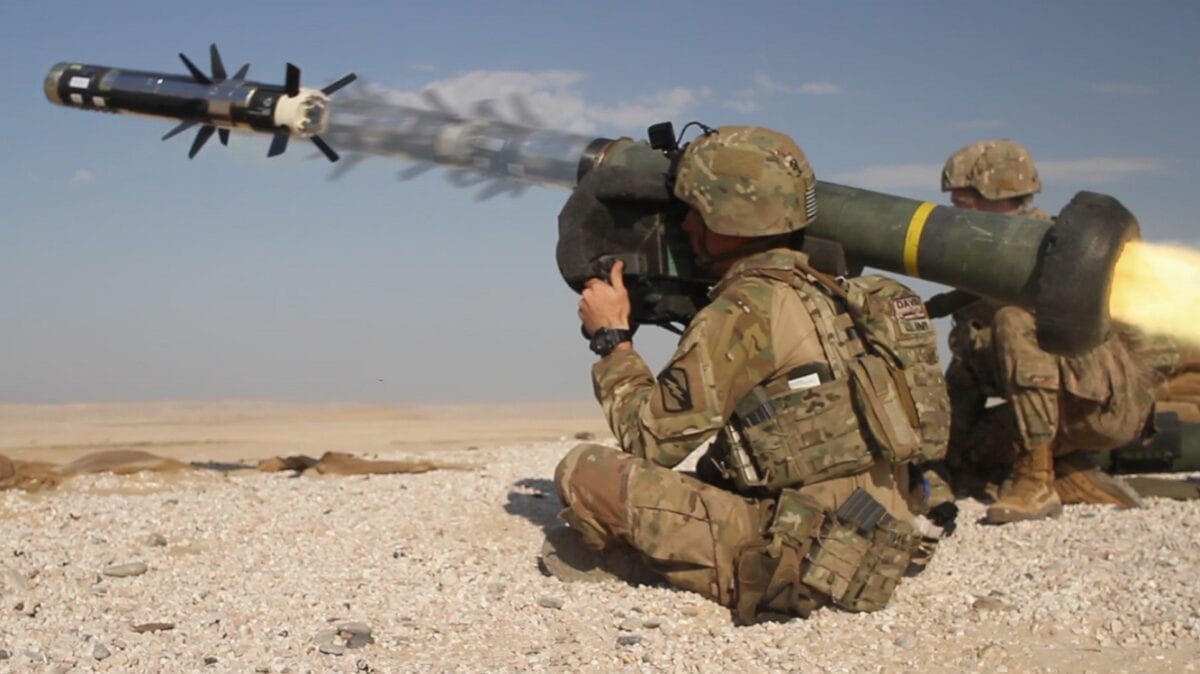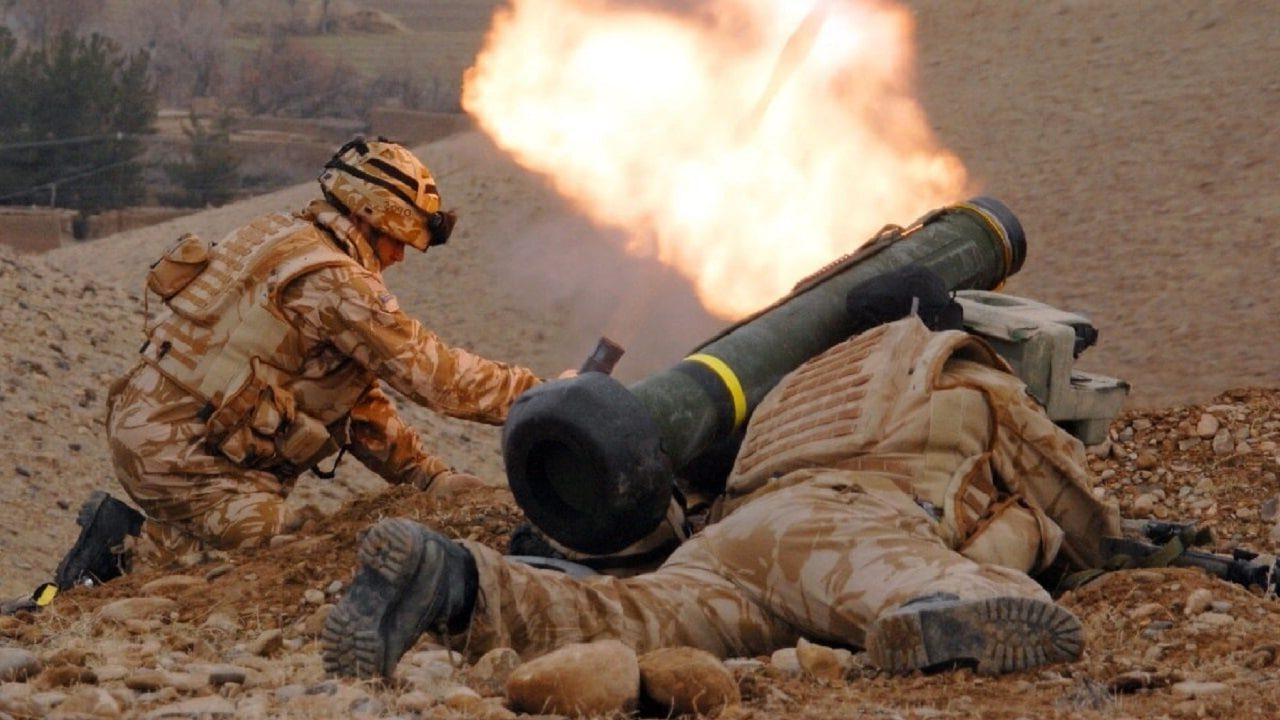FGM-148 Javelin Anti-Tank Missile a Symbol of the Ukrainian Resistance- Rare combat footage of an FGM-148 Javelin destroying a Russian BM-21 rocket launching system has emerged from the Ukrainian battlefield. 1945’s Sebastian Roblin posted the video, taken last April, to his Twitter feed. Although 1we cannot independently verify the authenticity of the video, the images demonstrate the intended use and celebrated effectiveness of the Javelin system.
Ukrainian Javelin missile strike on Russian truck-mounted Grad rocket artillery. You can see the Javelin’s top attack capability here, though quite redundant against such an unarmored target. Remarkable they were able to creep in range, though! https://t.co/JdQN0CpkAc
— Sebastien Roblin (@sebastienroblin) April 13, 2022
In the footage, a Ukrainian operator kneels, takes aim, and fires. The Javelin missile launches from the Command Launch Unit, climbs at a sharp angle and disappears from sight. Several seconds later, the missile descends from above, atop the Russian B-21, causing the Russian vehicle to explode.
What Makes the Javelin Special
The FGM-148 Javelin, or Advanced Anti-Tank Weapon System-Medium (AAWS-M) is an American-made portable anti-tank missile. The Javelin has been in service for nearly three decades, after making its debut in 1996. The system was a welcome improvement over its predecessor, the M47 Dragon, which relied on a wire-guided system to track a target. The wire-guided system was troublesome because it required operators to stay put while a spool of wire unraveled between the missile and the operator, allowing the missile to track the target. The M47 Dragon operator was essentially tethered to the deployed missile. By contrast, the Javelin uses an automatic infrared guidance system, which tracks the infrared light emission from a target. The infrared guidance is a “fire and forget” system, meaning the operator doesn’t have to sit tight while the missile tracks its target. Instead, the operator can fire the Javelin and get the hell out of harm’s way.
The Javelin can be operated with two distinct flight profiles. The first, depicted in the video footage, is a top-attack – a setting that allows for the Javelin to attack armored vehicles from above, where their armor is typically the thinnest. In top-attack mode, the Javelin missile climbs sharply after launching, reaching a peak altitude of 490 feet. The second mode, direct-attack, is ideal for use against fortifications, helicopters, or targets hiding beneath some form of obstruction. In direct-attack mode, the missile reaches a peak altitude of 200 feet. In either mode, the missile launches with a “soft launch.” In a soft-launch, the missile ejects from the launcher before the motors ignite – making it harder for enemies to identify the launcher’s location.
Whether attacking from above, or from head-on, the Javelin delivers a high-explosive anti-tank (HEAT) warhead. The HEAT warhead is a shaped charge, which is a form of explosive that focuses the effect of the explosion’s energy. In the case of the HEAT warhead, the shape is designed to penetrate armor. To achieve this effect, the HEAT warhead has an explosive charge that collapses a metal liner located within the warhead, creating a high-velocity superplastic jet. The superplast jet is what penetrates the armor. Curiously, penetration is achieved through kinetic effect – meaning, there is no explosive or incendiary sequence initiated upon impact. The HEAT warhead, and the Javelin system, have proven very capable – as the new footage suggests. Nearly two dozen countries operate the Javelin system worldwide. Including, of course, the Ukraine.
Beginning in 2018, Ukraine has received several thousand Javelin systems from the US and NATO. Now, staving off Russian advances, the Ukrainians have used the Javelin to kill hundreds of Russian tanks and thousands of Russian armored vehicles. Actually, the Javelin has become a symbol of the Ukrainian resistance; An image nicknamed “Saint Javelin,” which shows Mary Magdalene launching a Javelin missile, gained traction on social media. Yet, while the Javelin’s performance has been impressive thus far, long-term supply concerns are emerging. The Center for Strategic and International Studies (CSIS) notes that the US has already used one-third of its Javelin missiles to aid Ukraine. But, the US lacks the production capacity to replenish the lent Javelin’s. And since Russian tanks outnumber the number of Javelin missiles available, the Javelin may soon be in short supply.

1st Lt. Ryan Rogers assigned to 3rd Battalion, 187th Infantry Regiment, 3rd Brigade Combat Team, 101st Airborne Division (Air Assault), fires the Javelin shoulder-fired anti-tank missile during platoon live fire exercise at Fort Campbell, Ky. Jan. 30, 2019. (U.S. Army Photo by Capt. Justin Wright)

U.S. Army Spc. Colton Davis, an infantryman assigned to Company C, 2nd Battalion, 198th Armor Regiment, 155th Armored Brigade Combat Team, Mississippi Army National Guard, fires a Javelin shoulder-fired anti-tank missile during a combined arms live fire exercise as part of Exercise Eastern Action 2019 at Al-Ghalail Range in Qatar, Nov. 14, 2018. The multiple exposure photo demonstrates the multiple stages the missile goes through after it is fired by Davis. This is a multiple-exposure photo. (U.S. Army National Guard photo illustration by Spc. Jovi Prevot)

A U.S. Marine with 1st Battalion, 3rd Marines, fires a shoulder-fired Javelin missile during exercise Bougainville II at Pohakuloa Training Area, Hawaii, April 18, 2021. Bougainville II is the second phase of pre-deployment training conducted by the battalion designed to increase combat readiness through complex and realistic live-fire training. (U.S. Marine Corps photo by Cpl. Jacob Wilson)

U.S. Army Spc. Colton Davis, an infantryman assigned to Company C, 2nd Battalion, 198th Armor Regiment, 155th Armored Brigade Combat Team, Mississippi Army National Guard, fires a Javelin shoulder-fired anti-tank missile during a combined arms live fire exercise as part of Exercise Eastern Action 2019 at Al-Ghalail Range in Qatar, Nov. 14, 2018. The multiple exposure photo demonstrates the multiple stages the missile goes through after it is fired by Davis. This is a multiple-exposure photo. (U.S. Army National Guard photo illustration by Spc. Jovi Prevot)
Harrison Kass is a Senior Defense Editor at 19FortyFive. An attorney, pilot, guitarist, and minor pro hockey player, he joined the US Air Force as a Pilot Trainee but was medically discharged. Harrison has degrees from Lake Forest College, the University of Oregon School of Law, and New York University’s Graduate School of Arts & Science. He lives in Oregon and regularly listens to Dokken.

